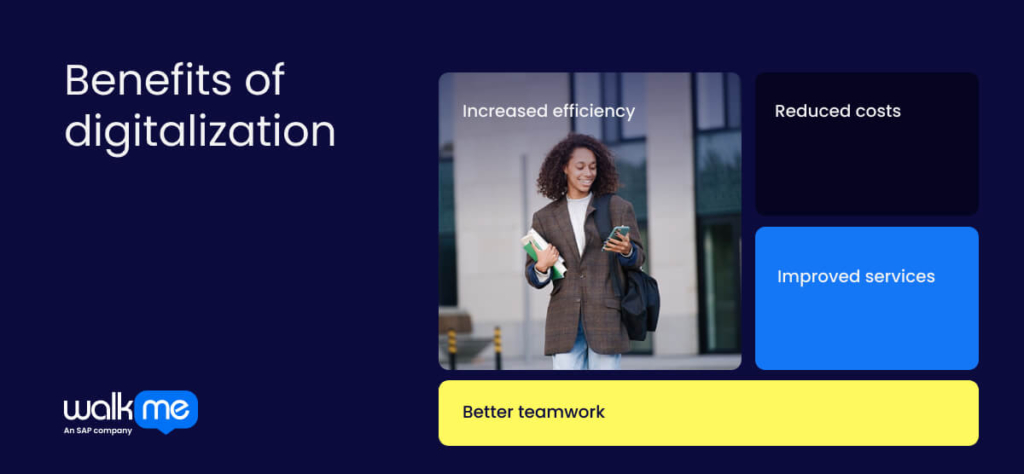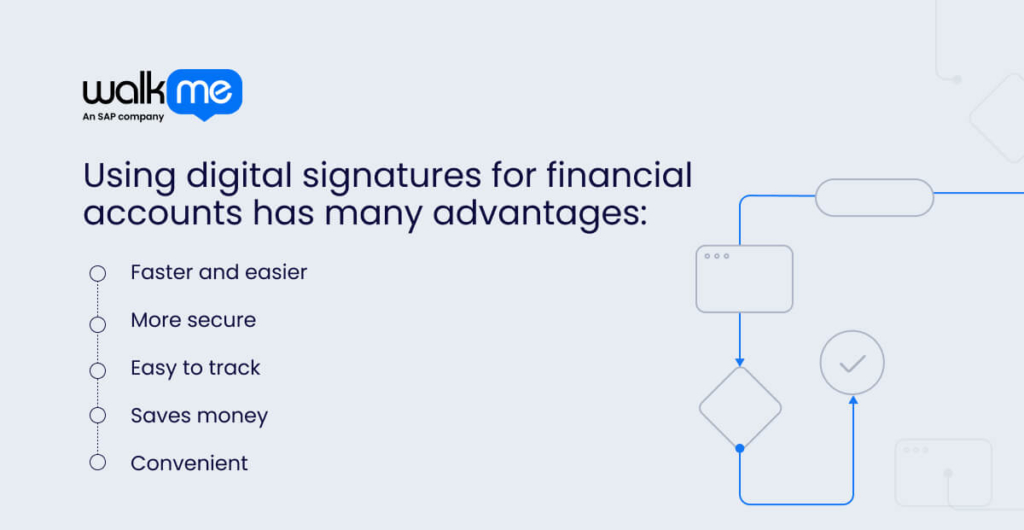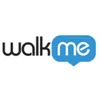As technologies like the Internet of Things (IoT) and AI continue to advance, businesses need to remain adaptable to improve customer experience. A study by Boston Consulting Group supports this as it says that today’s customers expect more personalized rewards.
To meet these expectations, businesses must understand how to use technology to reach goals and serve customers better. This requires knowing the difference between digitization and digitalization.
Digitization, or digital enablement, is the first step of transformative change. But, the next step of digitalization can change how a business runs and delivers value to customers.
This article will define both terms, explain their differences, and explain why both are important. We will also share examples from industries like healthcare and manufacturing.
What are digitization and digitalization?
Let’s define what digitization and digitalization mean before the comparison:
What is digitization?
Digitization changes old-fashioned ways of doing things into digital ones. But, this process doesn’t change the information itself. For example, scanning paper patient records makes it easier to manage patient care.
Digital files are easier to find because they’re protected with special codes. They’re also cheaper to store and last longer. You can make backup copies of digital files to protect them.
Businesses that use digitization have many benefits. It helps them work better and improve customer service and employee productivity. It improves collaborative work, and information is easier to share. Businesses need less physical storage space, and their work processes become more efficient.
What is digitalization?
Digitalization uses digital tools to change how businesses work. It improves how they do things, finds new ways to make money, and gives customers a better experience.

Digitalization has many benefits:
- Increased efficiency: Automating tasks and streamlining processes makes things faster.
- Reduced costs: Businesses can save money and find new ways to earn income.
- Improved services: Businesses can offer better services to their customers.
- Better teamwork: Teams can share, access, and analyze information. This improves communication and decision-making.
Key differences between digitization and digitalization
The vital differences between digitization and digitalization can be summarised here:
| Element | Digitization | Digitalization |
| Meaning | Transforming analog data into digital information. | Adopting digital technologies to change processes. |
| Objective | Improves accessibility and storage | Enables efficiency, better customer experiences, scalability, security and innovation |
| Goals | Focused on the conversion of information to a digital format. Represents the first step in adopting digital tools. | Aims to enhance the business’s competitiveness, processes and agility through technology. |
| Impact | Paves the way for digitalization, reduces storage costs and improves accessibility | Results in business transformation, innovation and new business models |
| Examples | Storing client information in a database | Using AI to predict market trends |
Examples of digitization and digitalization in business
Now that you understand the differences between the two, let’s dive into examples for both:
Healthcare
In healthcare, you can see digitization and digitalization in the following ways:
Digitization: Electronic health records
Using digital health records makes it easier to store and share patient information.
Its advantages are:
- Easier to use: Paper records become digital files, making them easy to find on computers.
- More accurate: Digital records are easier to read, which helps prevent mistakes.
- Saves space: Digital records take up less space. This makes it easier for many patients to store information.
- Faster to find: You can find patient information using keywords or special codes.
- Better teamwork: Doctors can share patient information, which improves care.
- More secure: Digital records track who accesses and changes patient information. This makes it more secure.
Digitalization: Telemedicine
Telemedicine uses video calls and electronic records to help people see doctors remotely.
Its benefits are:
- Better Access: This makes healthcare easier to get and saves on travel costs.
- Saves Time and Money: Video appointments are quicker and cheaper. This is especially for routine checkups.
- Improved Care: Doctors can share information, which helps prevent unnecessary tests.
- Better Monitoring: Special devices can track people’s health. This allows for early detection of problems.
Retail
Examples of digitization and digitalization in retail include:
Digitization: Digitizing inventory data
Changing physical inventory records (like purchase orders) to digital files makes it easier to manage inventory.
It allows:
- Real-time Tracking: You can see how much stock you have at any time.
- Fewer Errors: Using barcodes or RFID technology to track items. This reduces mistakes in counting.
- Better Decisions: You can see how much stock you have in all your locations. This helps you make better decisions about buying and storing inventory.
- Improved Accuracy: Automated updates make sure your records are always accurate.
- Saves Time and Money: Quick access to data and automated processes. This save time and reduce labor costs.
Digitalization: Smart mirrors
Smart mirrors make shopping easier. You don’t have to try on clothes in a dressing room.
It does this through:
- Faster Shopping: The mirror shows you how clothes look on you without changing. This saves time.
- Personalized Suggestions: The mirror suggests clothes based on what you’ve bought.
- Better Experience: You can see how clothes look in different lights. This helps you feel more confident about your choices. Improving the customer experience is a key part of digitalization.
- Easy to Use: You can talk to the mirror or use the touch screen to find things, buy clothes, and learn about deals.
Manufacturing
Digitization and digitalization is also common in manufacturing in the following ways:
Digitization: Digitizing maintenance logs
Changing paper maintenance records to digital files makes it much easier to track. It can also help you make better decisions about maintenance in manufacturing.
- Easy access: Digital records are easy to find, analyze, and update. You can access them from anywhere.
- Quick searches: You can find specific information using keywords and filters.
- Automated reports: Software can create reports and charts to help you track trends.
- Improved teamwork: Many people can access and update the information at the same time.
- Reduced errors: Digital records help prevent mistakes made when copying information.
- Automated alerts: Systems can send alerts for scheduled tasks or when there are serious problems.
Digitalization: Predictive maintenance through IoT sensors
IoT-enabled predictive maintenance is a key example of digitalization in manufacturing. Machine sensors collect large amounts of data, such as temperature, vibration, and pressure. You can analyze data in real-time using advanced algorithms. These can detect patterns and predict potential problems.
If a machine shows early signs of trouble, maintenance teams can schedule repairs during planned downtime. This reduces unexpected disruptions. Predictive maintenance also helps use resources well by focusing on likely issues. Addressing problems early can prevent serious damage, extending the life of equipment.
Banking
The banking sector can also benefit from digitization and digitalization in the following ways:
Digitization: Digitizing customer signatures for accounts

Using digital signatures for financial accounts has many advantages:
- Faster and easier: You don’t need to print, sign, and scan papers anymore. This saves time and makes things quicker.
- More secure: Digital signatures are safer than handwritten ones. They use special technology to make sure the signature is real.
- Easy to track: You can see who signed a document, when they signed it, and if you make any changes.
- Saves money: Using digital signatures can save money. It reduces the costs of printing, storing, and mailing papers.
- Convenient: You can sign documents from anywhere.
Digitalization: AI-driven personalized financial advice
Artificial intelligence (AI) helps banks give each customer a more personal experience.
Digitalization provides the tools for AI to analyze how people manage their money. This allows AI to give personalized financial advice to many people.
AI helps companies understand what customers need and want. Digital tools collect information on how people use their money. This information helps AI give personalized advice.
AI platforms make financial advice available anytime and anywhere. This removes the need to visit a physical bank.
For example, online banking platforms use AI to give you insights based on your finances. Financial planning apps use AI to create plans that fit your goals including your level of risk. AI chatbots can answer your questions and give you personalized suggestions.
These advancements make financial services more personal and easier to access.
Education
Two examples of digitization and digitalization with education are:
Digitization: Digitizing lecture notes
Changing handwritten notes into digital files makes them much easier to handle.
Digital files are simple to save, organize, and find. You don’t need to worry about losing or damaging paper notes. Optical character recognition (OCR) can even turn the writing into text you can edit.
Digital notes save time because you can search for keywords. You can organize them into folders. Sharing notes with others is also simple using online platforms.
With an internet connection, you can access your notes from any device. Unlike paper notes, you can back up your digital files to prevent losing them.
Digitalization: Adaptive learning platforms
Adaptive learning uses digitalization to make learning personal for each student.
These systems use information about how you learn to adjust the lessons. They change the speed and difficulty to fit your needs and goals. This helps you stay interested and learn better.
The system tracks how you’re doing to find areas where you need more help. It then guides you toward the right learning path. This makes learning more focused.
Personalized learning keeps you motivated by giving you the right level of challenge. You also save time by skipping what you already know. These systems can also help with different learning styles.
At work, these platforms help employees learn new skills and stay up-to-date. They also get better over time by using the information they collect. This keeps the learning relevant and helpful as things change.
Understanding digitization and digitalization is important for building strong strategies. First, they need to digitize their information. This means changing things like paper documents into computer files.
Then, they can use this digital information to digitalize their operations. This helps them work better and gives customers a better experience.
As businesses grow, they combine these steps into digital transformation. This means completely changing how they do things and finding new ways to make money.
The most important thing is to focus on the customer. By understanding what they want and think, businesses can meet their needs.
FAQs
Digitization and digitalization can greatly benefit industries such as healthcare, retail, finance, education, manufacturing, automotive, telecommunications, energy, utilities, and real estate.
Digitization is typically cheaper upfront as it only converts analog data into digital format. In contrast, digitalization involves integrating digital technologies across a business, transforming processes. This can result in higher costs due to system changes, training, and ongoing development.

